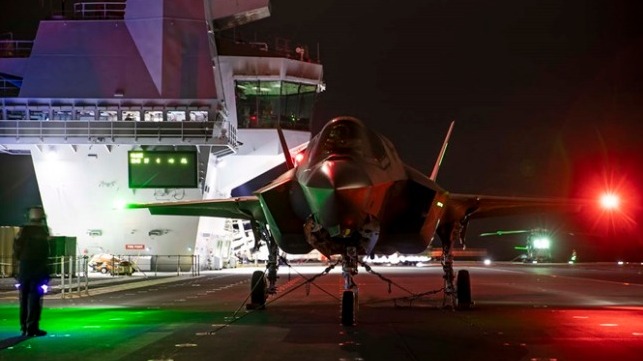F-35 Fighter Comes Alive for the Royal Navy

Royal Navy aviators can now fly the world’s most advanced fighter on front-line missions. In front of a new hangar built to house the stealth fighters at their home on land – RAF Marham in Norfolk – UK Defence Secretary Gavin Williamson announced the fifth-generation jet is now operational and ready to take its place in the nation’s aerial order of battle.
Nine F-35s are on UK soil at present, flying with the 617 ‘Dambusters’ Squadron. It is a Royal Air Force formation, but nearly half its personnel are Royal Navy pilots or engineers.
The declaration of Initial Operating Capability means the Lightning Force can conduct combat missions from land bases if world events require the stealth fighter’s intervention.
“This is great news for the Royal Navy and the United Kingdom as it is a key milestone along the road to operating the F-35 Lightning at the heart of our carrier strike capability from 2021,” said Commander James Blackmore, who has been involved in the program for the past decade and is now in charge of flying operations aboard HMS Queen Elizabeth. “As a fifth-generation fighter, the F-35 is streets ahead of anything we have operated before. It’s proving itself to be highly capable in air-to-air and air-to-ground operations."
The next key step for Britain is to declare the F-35 operational at sea, in time for the carrier HMS Queen Elizabeth's maiden deployment in 2021. So far the F-35, carrier and task group are on track to make that deadline. Test variants of the F-35 conducted a myriad of trials aboard the Portsmouth-based warship off the Eastern Seaboard last autumn. The data and experiences gathered are helping to ‘write the manual’ for safely operating F-35 squadrons when they embark – beginning this autumn with a return to the Eastern Seaboard of the USA. The deployment will focused on operations, rather than the basics of flying the F-35 on and off the carrier’s expansive deck, and working as part of a carrier task group.
“HMS Queen Elizabeth was designed from the keel up to support the F-35 and it showed. The ‘marriage’ between the ship and the aircraft was superb. We learned that together, we have got something quite special,” Commander Blackmore said. “It’s not just about the aircraft, however. The key now is to bring the aircraft together with a whole carrier task group to deliver a truly potent force – and we are on course to deliver that from 2021.”
The opinions expressed herein are the author's and not necessarily those of The Maritime Executive.
